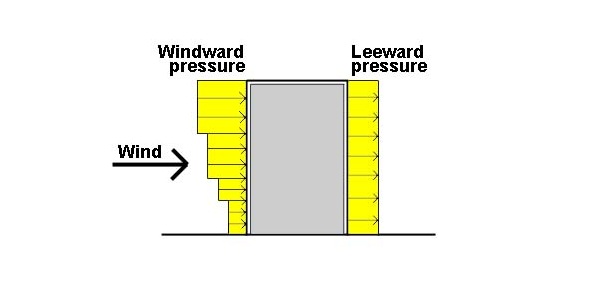
Any structure of a building is subjected to different loads first of all the weight of the structure itself; which is due to gravity. Similarly, the structure will have to resist load due to the weight of occupants, furniture, fixtures etc which is called live load. As the structure has to resist its load, it has also to resist loads due to wind, earthquake etc.
Buildings and other structures and other components and cladding shall always be designed and constructed to resist wind loads.
Pressure applied due to the wind on a structure is called wind load. This load gets distributed throughout the surface area of structure. The magnitude of this load increases as height of structure increases i.e. Taller structures has more effect due to the wind than shorter structures.
What is a Wind Load?

Angle obtained between the direction of wind and reference axis of structure is called angle of attack in wind load.

Design Wind Speed:
Wind Load is directly related to wind speed. The higher the speed, higher the wind load and vice versa. So wind speed of that area plays an important role for wind load on a structure. Wind speed at 10 m height above mean ground level is known as Basic Wind Speed. It is based on peak gust velocity averaged for a short time interval of about 3 seconds and corresponds to mean height above ground level in an open terrain. It is obtained by multiplying basic wind speed with 3 coefficients related to different factors as below:
- Risk level
- Terrain roughness, height and size of structure
- Local topography
Basic wind speed for different parts of India is shown on map below:

Courtesy- IS 875 (Part – III)

Courtesy - EIA
Terrain for wind speed:
A terrain is categorized on basis of its surrounding in mainly four categories:
01. Category 1
A terrain which is exposed(open) with few or no obstruction and in which height of an average object surrounding the structure is less than 1.5 m.
02. Category 2
An open terrain with well-scattered obstruction and obstructions generally having heights between 1.5 m to 10 m.
03. Category 3
A terrain having closely spaced obstructions of height up to 10 m and with or without a few isolated tall structures.
04. Category 4
A terrain having numerous large high closely spaced obstructions.
Indian Standard Code of practice for application of Wind Load on a structure are as follows:
- IS 875-3 (Indian Code)
- ASCE 7 (American Code)
- BS 6399-2 (British Code)
































